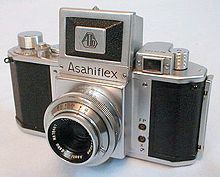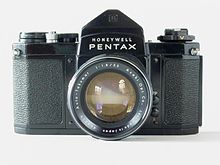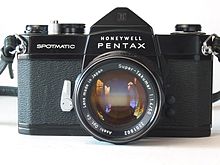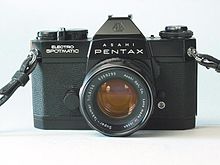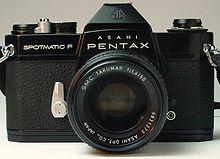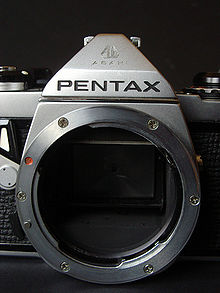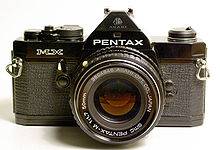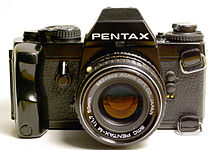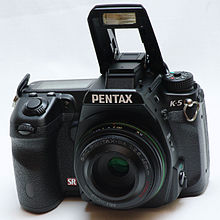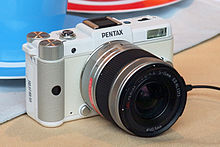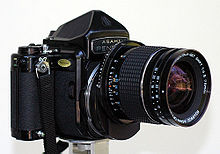- Pentax cameras
-
This article discusses the cameras – mainly 35 mm SLRs – manufactured by Hoya Corporation's Pentax division (ペンタックス Pentakkusu) and its predecessors, Pentax Corporation (ペンタックス株式会社 Pentakkusu Kabushiki-gaisha) and Asahi Optical Co., Ltd. (旭光学工業株式会社 Asahi Kōgaku Kōgyō Kabushiki-gaisha).
It covers from the first "Asahiflex" models in 1952 and their successor, the pivotal "Asahi Pentax" single-lens reflex camera, to the present time.
Contents
Background
The period around 1950 marked the return of the Japanese photographic industry to the vigorous level of the early 1940s, and its emergence as a major exporter. The newly reborn industry had sold many of its cameras to the occupation forces (with hugely more disposable income than the Japanese) and they were well received. The Korean War saw a huge influx of journalists and photographers to the Far East, where they were impressed by lenses from companies such as Nikon and Canon for their Leica rangefinder cameras, and also by bodies by these and other companies to supplement and replace the Leica and Contax cameras they were using. This was the background to the development of Asahi Optical's first camera.
The Screw mount cameras
The Asahiflex Series
Main article: AsahiflexAsahi Optical introduced its first 35 mm camera in 1952. Asahi was unusual in deciding to start with a high-quality 35mm camera that was not a copy of something else. Its designers were convinced of the inherent superiority of the SLR and so proceeded along these lines. This effort resulted in the Asahiflex I, which was also the first Japanese 35mm SLR.[1]
The Asahiflex I had a non-interchangeable waist-level viewfinder, with a direct optical viewfinder for eye-level use. The Asahiflex I had a non-returning mirror and shutter speeds from 1/25 to 1/500. The camera used the M37 screw mount. It went through some minor modifications for flash use, resulting in the IA. With the IIB a key advance was made: the quick-return mirror. The problem of mirror black-out was one of the main problems with prior SLR designs, greatly reducing usability and a major reason for the greater popularity of the rangefinder. With the IIB there emerged the first practical quick-return mirror, a vital innovation and one which was quickly adopted by other manufacturers. With the final model in the series, the IIA, the Asahiflex gained slow speeds from 1/25th of a second to 1/2 of a second.
- Asahiflex I (1952–1953)
- Asahiflex IA (1953–1954)
- Asahiflex IIB (1954–1956)
- Asahiflex IIA (1955–1957)
Asahi-Pentax Series (pre Spotmatic)
Main article: Asahi PentaxA recognized problem with the Asahiflex series was that, lacking a pentaprism, it was very difficult to use the camera in a vertical position and taking pictures of moving objects was almost impossible. The small viewfinder on top of the camera was of little use when the photographer wanted to use a 135 mm or 500 mm lens. The problem was recognized by Asahi. In 1957, Asahi introduced the Pentax series, a 35 mm single-lens reflex camera (SLR) camera which was so well received that it influenced the design of 35 mm SLRs worldwide for years to come. The Pentax and its later development and likewise classic 1964 Pentax Spotmatic spurred the development of Asahi into a photographic multinational company, eventually renaming itself "Pentax" after its seminal product. The Pentax series remains pivotal in the development of modern SLR photography.
There is some confusion about the etymology of the name. Some sources claim it was licensed from VEB Zeiss Ikon, and derived from the combination "PENTAprism" and "contaX". The explanation on pentax.com does not mention Contax or Zeiss Ikon, and states that the name was formed from "PENTAprism" and "refleX", being the reflex mirror of an SLR camera. A third variation substitutes "Asahiflex" for "reflex", which is at least logical as the Asahiflex cameras had waist-level viewfinders and therefore the pentaprism of the Asahi Pentax would have been a significant differentiating feature.
The Asahi Pentax of 1957 featured:
- Pentaprism
- Rapid-wind film advance lever. Earlier 35 mm SLRs, with the sole exception of Exakta's left-handed lever, had knob winders.
- Film rewind crank, likewise a first for 35 mm SLRs.
- Instant mirror return, unique to the Pentax and its immediate predecessor, the Asahiflex IIb
- Microprism focusing aids on the focus screen, unique to the Pentax
Moreover, the Pentax placed controls in locations that would become standard on 35 mm SLRs from all manufacturers, such as the right-handed rapid wind lever, the bottom right mounted rewind release, and film speed reminder around the film rewind crank.
The photographic giants Canon & Nikon, did not introduce their own SLR cameras until 1959 with the Canonflex and the F-series respectively. By contrast, the Pentax series offered these features at a relatively low price, introducing many photographers to 35 mm SLR photography.
The Asahi Pentax series went through various iterations until 1964. Each successive model incorporated minor improvements, the most noticeable being the incorporation of the two shutter speed dials (one for high speeds and one for low speeds) into one. The AP of 1957 is externally almost identical to the 1964 SV.
Spotmatic Series
Main article: Pentax SpotmaticHowever, by the 1960s the clamour for in-camera exposure metering was rising. It was possible to attach an external CdS (Cadmium sulfide) exposure meter to the later AP-derived models, but in 1960 the next breakthrough arrived. At the 1960 Photokina camera show, Asahi exhibited the Spot-matic prototype. This camera took exposure measurements, via a spotmeter, through the taking lens, an incredible innovation. The camera excited tremendous attention and in 1964 the first production Spotmatic (hyphen dropped) emerged. The Spotmatic was virtually identical to the prototype; however, the spotmeter was replaced with an all-over average-reading exposure meter in order to give more consistent results. The camera was an instant success and was snapped up by the thousands, although Asahi had been beaten into production by the Topcon RE Super which went on sale in April 1963; the Topcon failed to attract the same degree of commercial success. The Spotmatic was replaced by the Spotmatic II with many upgrades 1971 - 1976.
In 1966 Asahi Optical had produced one million SLR cameras since the first Asahiflex of 1952. It took them only another three years, until 1969, to reach two million. This period was a time of complete pre-eminence for Asahi Optical. During the Spotmatic era Asahi were manufacturing more SLRs per month than all the other camera manufacturers combined. One of the technological highlights was the Electro-Spotmatic of 1971. This camera was one of the very first to incorporate automatic exposure. The series concluded in 1973 with the introduction of the Spotmatic F (now incorporating open-aperture metering rather than the stop-down metering of the early models).
 28mm f/2.8 SMC Shift lens, 11 mm maximum shift
28mm f/2.8 SMC Shift lens, 11 mm maximum shift
However by the mid-1970s the limitations of the M42 mount were being felt. By this time most other manufacturers had opted for a bayonet lens mount. It was a great step for Asahi Optical to take but the M42 screw mount, by now widely known as 'Pentax screw mount', had reached the end of its useful life. Pentax were now to adopt the lens mount that would see them through the next 30 years.
Other Prototypes
In 1960, the same year that Asahi Optical introduced the Spot-matic prototype at Photokina, they also showed another SLR prototype which they called the Metallica. The Metallica gave a glimpse into the future direction of Pentax cameras; it featured a prototype bayonet lens mount, a vertical-traveling, metallic Copal-type focal plane shutter (from which the camera drew its name), and an already obsolescent coupled selenium light meter. The light meter was not TTL, but instead featured the typical large selenium mini-lens pattern on the front of the pentaprism. Otherwise the camera resembled the Spot-matic in appearance. While Asahi Optical didn't put the Metallica into production, the concepts of a bayonet lens mount and a metal focal plane shutter were already being discussed internally at the company.
In 1966 Asahi Optical showed a revised prototype of the Metallica named the Metallica II. Gone was the cumbersome selenium light meter, replaced with a now standard internal CdS meter. The Metallica II retained the bayonet lens mount shown in the earlier 1960 prototype, and also featured an improved Copal-square metallic shutter. But the biggest innovation was the fully automatic shutter operation coupled to the TTL meter. The metering system, for the first time in a 35mm SLR, controlled the shutter speed automatically based on the aperture set. With these innovative developments, the Metallica II pioneered features that would not surface on Pentax production cameras until the Electro-Spotmatic (ES) (automatic aperture-priority exposure) in 1971 and K2 (vertical metal shutter, bayonet lens mount, automatic aperture-priority exposure) in 1975. (Cecchi 1991:80-86)
K Mount cameras
Main article: Pentax K mountK Series
- K2 (1975–1980)
- KX (1975–1977)
- KM (1975–1977)
- K1000 (1976–1997)
Three new models were introduced at once in 1975: the K2, KM and KX. The KM was almost identical in features and operation to the Spotmatic F. The KX featured a better TTL light meter using SPD (silicon photodiodes), visible aperture and shutter speeds in the viewfinder, and a mirror lock-up mechanism. The K2, the flagship model, incorporated aperture-priority autoexposure with a fully manually selectable range of shutter speeds from 8s to 1/1000. The only other aperture priority camera Pentax had made up to this point, the ES series, only had manual shutter speeds from 1/60 upwards. A special version of the K2 was also produced (called the K2DMD) to use a motor drive and data back. A later addition to the K series was the K1000 (basically a KM stripped of its self-timer and depth of field preview), later to find fame as the perennial camera of choice for photography students.
What set these cameras apart from any earlier Pentax was the removal of the M42 lens mount. With the K series of cameras, Pentax followed its rivals and introduced its own bayonet mount, the K mount. Still the basis for Pentax lenses and cameras today, this offered greater convenience and enabled the production of faster lenses such as the 50 mm f/1.2.[2] Eager to keep M42 users in the Pentax system, an M42-K Mount adaptor was offered, enabling M42 users to continue to use their existing lenses (with loss of automation).
The K series cameras followed the design ethos of the time, big and heavy. But scarcely had the K series been introduced, than Pentax began working on a new camera line, a new camera line reflecting a new ethos - one which continues to influence Pentax to this day.
M Series
The M series cameras were noted for their compact size, among the smallest and lightest 35 mm SLRs ever made. Except for the MX, all were based on the same basic camera body, and featured aperture-priority exposure automation. While superficially resembling the ME, the MX was designed as a manual-only SLR system targeted to the advanced amateur or professional photographer, and had its own set of accessories that were mostly incompatible with the other M series cameras. Conversely, the other M-series cameras were targeted squarely at casual users. None of the M-series, with the exception of the MX, featured a depth of field preview.
The ME featured aperture-priorty only automation with no manual override. The MX was entirely manual and resembled the earlier KX in features. The ME Super was an ME with a manual mode. The MG, MV, and MV1 were even simpler versions of the original ME.
The ME-F was an early attempt at an autofocus SLR using a special 35-70mm zoom with a motor built into the lens.
- ME-F (1981–1988)
- ME (1976–1980)
- ME Super (1980–1987)
- MG (1982–1985)
- MV (1979–1982)
- MV1[3] (1979–1982)
- MX (1976–1985)
A Series
The A series added fully programmed exposure control (adjusting both aperture and shutter speed automatically) to the M series. To enable control of the lens aperture by the camera body, it used the new KA-mount, a backward-compatible modification that also allowed the array of standard K-mount lenses to be used in manual and aperture-priority exposure modes. The A series were the first cameras from Pentax to use LCD digital displays for exposure information in the viewfinder. The super A / super PROGRAM and the program A / program PLUS both used a translucent white window on the front of the pentaprism to provide backlight to the LCD display without having to use the battery for illumination.
- super A / super PROGRAM (1983–1987)
- program A / program PLUS (1984–1988)
- A3/A3000 (1985–1987)
LX
The Pentax LX model was a tough, professional-grade competitor to the Nikon F3, the Canon F-1, Olympus OM cameras, and Contax RTS. It is rugged, weatherised and sealed against dust, yet compact and light. It has interchangeable focusing screen and viewfinder; the S69 screen is particularly bright. The LX uses an advanced metering system that also reads the light falling on the film and the first shutter curtain during exposure, the TTL OTF (off the film) feature, a Minolta patent, but utilised by Olympus in the OM-2 in 1975. The selected aperture value and shutter speed are shown in the viewfinder. The camera remained in production for more than 20 years.
- LX (1980–2001)
P Series
- P5/P50 (1986–1989)
- P3/P30 (1985–1988)
- P3n/P30n (1988–1990)
- P30t (1990–1997)
SF Series
The SFX (called the SF1 in the US) was the world's first AF SLR with built-in TTL auto flash, which is retractable. Pentax has referred to the built-in flash as "RTF" (Retractable TTL Flash) ever since then.[4] Pentax SAFOX I (Sensor Ability Fortifying Optical Compensating System) autofocus module was integrated to these series.
- SFX/SF1 (1987–1989)
- SFXn/SF1n (1989–1993)
- SF7/SF10 (1988–1993)
Z/Pz Series
The second generation of autofocus cameras from Pentax. They are equipped with new SAFOX II autofocus module and power contact to enable power zoom function in power zoom FA lenses.
- PZ-10 (1991)
- PZ-1 (1991)
- PZ-20 (1992)
- PZ-50 (1992)
- PZ-1P (flagship model) (1994)
- PZ-5P (flagship model) (1994)
- PZ-70 (1995)
MZ/ZX Series
This innovative series brought the "small and light" concept back from previous generation manual focus cameras. This series known as MZ models elsewhere were named ZX models in the USA except MZ-S, the MZ-5 being known as the ZX-5 in the USA. The exception to this rule was the MZ-6 which was known as the ZX-L in the USA. Models shown on the same row are model replacements/upgrades in the range, so the MZ-10 was replaced by the MZ-7 which was subsequently replaced by the MZ-6.
All members of this series are compact autofocus SLRs except the MZ-M. The flagship model in this series is the MZ-S which body materials are metal, faster film drive and higher flash sync speed. Only MZ-S and MZ-6 are compatible with newly introduced P-TTL flash system. Both models can control remote flash wirelessly by popup flash commander mode in normal or high-speed flash sync.
SAFOX IV/V autofocus module are integrated into this series.
Models which were also backward compatible with both the KA and K mounts:
MZ-S (Flagship model)
MZ-3
MZ-5 MZ-5n
MZ-10 MZ-7 MZ-6/ZX-L
MZ-M (manual focus version and no built in flash)Models which were backward compatible with the KA mount but not the K mount:
MZ50 MZ30
MZ60*ist Series (Film)
*ist (2003–2006)
Digital
MZ-D Prototype
The Pentax MZ-D, also known by its internal code name of MR-52, was a prototype digital single-lens reflex camera. It was announced at Photokina in September 2000 and was demonstrated to the press at the Photo Marketing Association (PMA) show in January 2001. In October 2003, Pentax canceled the camera, stating "The cost of manufacturing the prototype SLR 6-megapixel digital camera meant it was not a viable product for our target market."
*ist Series (Digital)
In 2003 Pentax introduced their first Digital SLR under Digital *ist series and released the first flagship model, the Pentax *ist D which uses a Sony 6 megapixel CCD. Since 2003, the *ist D is the only digital SLR that can control HS wireless P-TTL from its pop-up flash and has many advanced features for professional applications. In 2004 Pentax released the second member in the digital *ist line, the Pentax *ist DS which is the first real consumer model (retailing under $1,000 USD). What set Pentax D and DS DSLRs apart from the competition was the clarity and high magnification provided by their pentaprism viewfinders, a very useful feature considering the support for legacy manual focus lenses. In 2005 Pentax released the Pentax *ist DL, a model with fewer features than the D and DS with a lower price. All Pentax's digital SLRs are compatible with K-mount lenses, and M42 (42 mm screw mount) lenses (with adaptor). Due to the smaller size of the CCD, lenses have an effective field of view of 1.5 × times the same lens in 35 mm format. So, where a 50 mm lens was considered a "normal" lens on 35 mm film, that same lens on a 1.5× "crop factor" camera has the field of view of a 75 mm lens on film. This only uses the center of the lens' projected image. To address this "crop factor," Pentax created a new series of lenses that were designed only to cover the smaller sensor. These are the DA series for their digital SLRs, which still feature the K-mount but have a smaller back-focus element designed specifically for use with the Digital SLR lineup. The DA series lenses do not have a mechanical aperture ring and so are not backward compatible with some earlier film bodies. The later D-FA lens series re-introduces a mechanical aperture ring and so is fully compatible with both film and digital SLRs.
SAFOX VIII are integrated into this camera series.
- *ist D Flagship model (2003–2006)
- *ist DS (2004–2005)
- *ist DS2 (2005–2006)
- *ist DL (2005–2006)
- *ist DL2 (2006)
K Series (Digital)
In May 2006, Pentax announced a new line of Digital SLR cameras to replace Digital *ist series. The K100D and K110D replaced *ist DL2 and DS2, while incorporating in-body shake reduction in the K100D model.[5] The Pentax K10D, a new flagship model in Digital K series replaced *ist D, adopted Sony 10-megapixel CCD sensor and weather-sealing construction, was announced on 14 September 2006.
The K10D featured a pentaprism viewfinder (instead of the slightly dimmer pentamirror on some previous models), full programmed, aperture and shutter priority modes, and a new Sensitivity-priority mode where the rear dial adjusts light sensitivity and the camera adjusts shutter speed and aperture to maintain correct exposure. Power contacts on the lens mount were introduced to enable Pentax's SDM (Supersonic Drive Motor) for silent focusing. The power contacts also provide the power zoom function in some FA lens that Pentax introduced in the 1990s. In addition, the K10D could write JPEGs and two versions of RAW files (PEF, and the Adobe specification DNG).
The K100D Super was a slight upgrade to the K100D announced in June 2007. The upgrade included some features from the K10D, such as an improved shake reduction (SR) system, a dust removal system, and power contacts for SDM lenses, but which could not enable the power zoom function as the K10D.
On January 23, 2008, Pentax announced the K20D and K200D, which replaced the K10D and K100D series respectively.[6] The K20D featured a Samsung 14.6 megapixel CMOS APS-C sized sensor, a special 21 frame/s burst mode, live preview on the LCD display, and an increased sensitivity range extending to ISO 3200. The K200D adopted the 10 megapixel sensor and weather sealing of the K10D, among other improvements, while retaining the smaller body size of the K100D Super.
The K-m / K2000 for US was announced on September 22, 2008 at the 2008 Photokina trade show along with the DA-L series of lightweight, inexpensive lenses.[7]
On May 20, 2009, Pentax announced the K-7 as a replacement for the K20D. It introduced an updated version of the Samsung CMOS sensor, but with an entirely new compact design. Notable new features included full metal body construction, a pentaprism viewfinder covering 100% of the frame, 720p video capture, a quieter and faster shutter mechanism, and the ability to apply automatic corrections for lens distortion and lateral chromatic aberration. This flagship model uses a 77 multi-zone metering system and updated focus - SAFOX VIII+. The K-7 was available from July 2009.[8][9]
In September 2009 the K-x, was introduced to replace the entry level K-m / K2000 (US).[10] It is regarded as one of the best APS-C DSLRs in terms of overall image quality, especially in high ISO performance.[11]
In September 2010 Pentax announced the K-r, a 6 frames per second 12.4 megapixel camera[12] and the K-5, a 7 frames per second 16.3 megapixel camera.[13] These cameras use a new, faster autofocus system, SAFOX IX.[14]
- Pentax K100D (2006–2007)
- Pentax K110D (2006–2007)
- Pentax K10D (2006–2008)
- Pentax K10D Grand Prix (limited edition) (2007)
- Pentax K100D Super (2007–2008)
- Pentax K200D (2008–2009)
- Pentax K20D (2008–2009)
- Pentax K-m (Pentax K2000 in U.S.) (2008–2009)
- Pentax K-7 (2009–present)
- Pentax K-x (2009–present)
- Pentax K-r (2010–present)
- Pentax K-5 (2010–present)
645D
In March 2010 Pentax announced its first medium format digital camera, the Pentax 645D.[15] The camera has been in and out of development since 2003 and went on sale in Japan in May 2010 at MSRP of ¥850,000, with supplies to the rest of the world expected to start soon after. It is targeted at professionals doing outdoor photography—camera body features very high level of airtightness. It uses a 40 megapixels, 44 mm × 33 mm CCD sensor. At the same time, new series of lenses designated D FA 645 was also released.[16]
Pentax Q
In June 2011 Pentax announced the 'Q' mirrorless interchangeable lens camera and the 'Q-mount' lens system. At release, it will have a small 1/2.3 inch 12.4 megapixel CMOS sensor.[17]
Optio (Digital)
Pentax Optio A30 has a 10 MP 1/1.8" image sensor, a 3x zoom lens, a 2.5" LCD display screen, and in-body SR similar to that used on Pentax DSLR models.
Pentax Optio A40 has a 12 MP 1/1.8" image sensor, a 3x zoom lens, a 2.5" LCD display screen, and in-body SR similar to that used on Pentax DSLR models.
Pentax Optio E40 has an 8 MP image sensor, a 3x zoom lens, a 2.4" LCD display screen, and supports standard AA batteries.
Pentax Optio E80 has a 10 MP image sensor, a 3x zoom lens, a 2.7" LCD display screen, and offers HD video recording.
Pentax Optio E90 has a 10.1 MP image sensor, a 3x zoom lens, a 2.7" LCD display screen, and offers HD video recording. Features rubberized surface. Comes in black and cherry red.
Pentax Optio H90 has a 12.1 MP image sensor, a wide-angle 28-140mm (5x) optical zoom lens, a 2.7" LCD display screen, and offers widescreen 720p HD video capture at 30 frame/s recording. Features advance pixel track shake reduction. Compatible with the SDHC technology. Comes in black, white, and orange.[18]
Pentax Optio I-10 has a 12.1 MP image sensor, a wide-angle 28-140mm (5x) optical zoom lens, a 2.7" 16/9 LCD display screen, and offers HD video recording. Its design is reminiscent of nearly all Pentax SLRs and is similar in size to the old Auto 110 SLR camera, this makes it a "retro-stylish" camera (classic look, slim design). Comes in black, white and "classic" (silver & black).
Pentax Optio M20 has an 7 MP image sensor, a 3x zoom lens, and a 2.5" LCD display screen.
Pentax Optio M40 has an 8 MP image sensor, a 3x zoom lens, and a 2.5" LCD display screen.
Pentax Optio P80 has a 12 MP image sensor, a 4x zoom lens, a 2.7" LCD display screen, and offers HD video recording.
Pentax Optio RS1000 has a 14.1 MP image sensor, a 4x zoom lens, a 3.0" LCD display screen. Comes in sunset palm color.
Pentax Optio RZ10 has a 14.1 MP image sensor, a 10x zoom lens, a 2.7" LCD display screen, and offers 720p HD video at 30 frame/s recording. Features sensor shift shake reduction. Comes in black, lime, violet, and white.
Pentax Optio S10 has a 10 MP image sensor, a 3x zoom lens, a 2.5" LCD display screen, and is DivX certified.
Pentax Optio V10 has an 8 MP image sensor, a 3x zoom lens, and a 3.0" LCD display screen.
Pentax Optio W10 has a 6 MP image sensor, an internally zooming 3x zoom lens, 2.5" LCD display screen, and is waterproof - 30 minutes of continuous operation at an underwater depth up to five feet, and dustproof (Class 5 dustproof performance of category 2).[19]
Pentax Optio WPi has a 6 MP image sensor, an internally zooming 3x zoom lens, 2.0" low-reflection LCD display screen, and is waterproof (JIS Class 8 water resistant rating). Continuous underwater picture-taking possible for 30 minutes at a depth of 1.5m to ten feet for up to 2.5 hours at a time.[20]
Pentax Optio W30 has a 7 MP image sensor, an internally zooming 3x zoom lens, 2.5" LCD display screen, and is waterproof to ten feet for up to 2.5 hours at a time.
Pentax Optio W80 has a 12.1 MP image sensor, a 28-140mm (5x) zoom lens, 2.5" LCD display screen, and is waterproof to 5 meters for up to 2.5 hours at a time. It also offers HD video recording.
Pentax Optio W90 has a 12.1MP CCD image sensor, a 28-140mm (5x) optical zoom lens plus 6.25x digital zoom, 2.7" LCD display screen, waterproof up to 6 meters, HD video 720p30 and also offers "Ring flash" by three front-mounted bright LEDs clustered around the lens. Comes in orange, black, and pistachio.[21]
Pentax Optio WS80 has a 10 MP image sensor, a 35-175mm (5x) zoom lens, 2.7" LCD display screen, and is waterproof to 1.5 meters for up to 2 hours at a time.
Pentax Optio X90 has a 12.1 MP image sensor, a 26-676mm megazoom (26x) lens, a 2.7" LCD display screen. Fast shooting at up to 11 frame/s. 1 cm super macro mode. Comes in professional black.[22]
Pentax Optio Z10 has an 8 MP image sensor, an internally zooming 7x zoom lens, a 2.5" LCD display screen, and in-body SR similar to that used on Pentax DSLR models.
Other formats
Pentax is one of the few camera manufacturers still producing medium format cameras. As of 2008[update], there are two offerings, one in the 6×7 format, the Pentax 67 II and one in the 6×4.5 format (Pentax 645NII). Both use 120 roll film. These cameras build on the Pentax SLR design experience. The shape of the Pentax 67 is broadly similar to a 35 mm SLR camera. By contrast, the Pentax 645 resembles other medium-format cameras by makers such as Mamiya and Bronica, which tend to be cube-shaped.
Another interesting product was the tiny Auto 110 reflex system, based on the 110 pocket-instamatic film format.
See also
- List of Pentax products
- List of digital camera brands
- List of photographic equipment makers
- History of the single-lens reflex camera
- Pentax lenses
References
- ^ The Japanese Historical Camera, p.58. (Japanese SLR cameras go back to Konishi's Sakura Reflex Prano of 1907. The Japanese Historical Camera, p.5.)
- ^ However, there were 55/1.2 M42 lenses from Tomioka/Yashica and Cosina ((Japanese) shown here).
- ^ Michael McBroom. McBroom's Camera Bluebook. p. 144. http://books.google.co.uk/books?id=sY2neBqnpTwC&pg=PA144&lpg=PA144&dq=pentax+mv+1&source=bl&ots=3gEIPfX8yF&sig=n-7DivVApg5tsEYRpBkdPHdhYiY&hl=en&ei=xDfuTO3FDIqChQfd4uT7Cw&sa=X&oi=book_result&ct=result&resnum=9&ved=0CFEQ6AEwCDge#v=onepage&q=pentax%20mv%201&f=false.
- ^ "Pentax History of Innovations 1980-1989". Pentax Imaging. http://www.pentaximaging.com/world_of_pentax/history_of_innovations/1980-1989/index.jsp. Retrieved 2007-08-30.
- ^ "Digital SLR Camera: K100D". Pentax. http://www.digital.pentax.co.jp/en/35mm/k100d/spec.html.
- ^ "Pentax announces K20D with 14.6 megapixels, K200D, and five new lenses" (Press release). Pentax imaging. 2008-01-23. http://www.pentaximaging.com/footer/news_media_article?ArticleId=10507458.
- ^ "Pentax announces K2000 Digital SLR system" (Press release). Pentax imaging. 2008-09-22. http://www.pentaximaging.com/footer/news_media_article?ArticleId=10541171.
- ^ "Pentax K-7 SLR Digital Camera". B&H Photo. 2009-05-20. http://www.bhphotovideo.com/c/product/622079-REG/Pentax__K_7_SLR_Digital_Camera.html.
- ^ "PENTAX K-7. A Mid-Class Digital SLR Camera". HOYA. 2009-05-21. http://www.pentax.jp/english/news/2009/200906.html.
- ^ "PENTAX K-x: A High-Performance Entry-Class Digital SLR Camera, Packaging Movie Recording, High-Speed Continuous Shooting and User-Friendly Operation in Compact, Lightweight Body" (Press release). Pentax imaging. 2009-09-16. http://www.pentax.jp/english/news/2009/200918.html.
- ^ "Pentax K-x Digital Camera - Full Review - The Imaging Resource!". Imaging Resource. 2010-03-09. http://www.imaging-resource.com/PRODS/KX/KXA.HTM.
- ^ http://www.pentaximaging.com/slr/K-r_Black/
- ^ http://www.dpreview.com/news/1009/10092020pentaxk5preview.asp
- ^ http://www.dpreview.com/previews/pentaxk5/
- ^ Pentax unveils 40MP 645D medium format DSLR
- ^ Pentax 645D specifications
- ^ Pentax Q small-sensor mirrorless camera announced and previewed
- ^ http://www.pentaximaging.com/digital-camera/Optio_H90_Black/
- ^ Steves Digicams - Pentax Optio W10 User Review
- ^ Steves Digicams - Pentax Optio WPi User Review
- ^ http://www.reghardware.com/2010/06/04/review_camera_pentax_optio_w90/print.html
- ^ http://www.pentaximaging.com/digital-camera/X90/
External links
- (English) The largest database of M42 mount lenses and Pentax K compatible (more than 5000 models) PhotoPentax.com
Categories:- Pentax cameras
- SLR cameras
Wikimedia Foundation. 2010.

